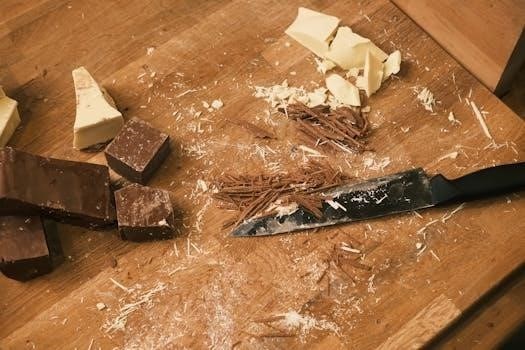Understanding Knife Sharpening Angles
The angle at which you sharpen a knife significantly influences its cutting performance, durability, and overall functionality. Knowing the correct angle for each knife is crucial for optimal maintenance and performance.
Why Sharpening Angle Matters
The sharpening angle is paramount because it directly impacts a knife’s cutting ability and edge retention. A lower angle, like 17 degrees, provides a sharper edge ideal for slicing but may be more prone to damage. Conversely, a higher angle, such as 22-30 degrees, results in a more durable edge, suitable for tougher tasks, but it might not be as sharp. The correct angle for a knife depends on its intended use. Choosing the right angle ensures the knife performs at its best. Understanding this relationship helps users choose the appropriate angle for different cutting tasks. Consistent sharpening at the right angle maintains the blade’s sharpness and extends its life. Failing to maintain the optimal angle will significantly reduce the knife’s performance and durability.

Factors Influencing Sharpening Angle Choice
Several factors determine the ideal sharpening angle for a knife. The type of knife is crucial, as a fillet knife requires a lower angle for precision, while a hunting knife needs a higher angle for durability. The blade’s steel type also matters; harder steels can maintain a lower angle better. Blade thickness also plays a role, with thinner blades generally suited to lower angles. The intended use is paramount; knives for soft materials benefit from sharper angles, whereas tougher materials require more robust edges. User preference also influences the choice, as some may favor a sharper edge at the cost of durability, and vice versa. These factors collectively influence the choice of the most appropriate sharpening angle.

DIY Angle Guide Methods
Creating your own angle guide can be simple and effective. Paper folding and adjustable guides offer easy ways to achieve consistent sharpening angles without special equipment.
Using Paper Folding for 20-Degree Angle
A quick and easy method to find a 20-degree angle involves a simple piece of paper. This technique is particularly useful when you need a fast guide without specialized tools. Begin by taking a standard rectangular piece of paper. Fold the paper in half, bringing one of the shorter edges to meet the opposite edge. Crease the fold sharply. Next, fold the paper in half again, aligning the previously folded edge with the opposite edge. Crease this second fold also. The resulting folded paper will now have four layers, and the angle formed at the corner is approximately 22.5 degrees. While not exactly 20 degrees, it serves as an excellent reference point for sharpening. This method provides a close approximation, and you can use it to visually guide your knife during the sharpening process, ensuring a generally consistent angle. This technique is very helpful for achieving a good sharpening angle.
Adjustable Angle Guides
For those seeking more precision than paper folding can offer, adjustable angle guides are an excellent option. These guides typically consist of a base and an adjustable arm that can be set to various angles. They provide a more reliable and consistent way to maintain the desired sharpening angle. Many of these guides are designed to work with different types of sharpening tools, such as whetstones or sharpening steels, making them highly versatile. To use an adjustable guide, you must first set the arm to the desired angle, using the guide’s markings or a protractor. Once the angle is set, you can place your knife’s blade against the guide, ensuring it maintains the correct position throughout the sharpening process. This method helps to develop muscle memory for consistent sharpening. The use of an adjustable guide allows for greater accuracy.

Recommended Sharpening Angles
Different types of knives require different sharpening angles to optimize their performance. Choosing the right angle ensures your knives will maintain a sharp, durable edge for their specific tasks.
General Purpose Kitchen Knives⁚ 17-20 Degrees
For most kitchen tasks, a sharpening angle between 17 and 20 degrees is ideal. This range offers a good balance between sharpness and durability, suitable for slicing, dicing, and chopping various foods. Many manufacturers recommend this range for their knives, aiming to provide a versatile edge that can handle a variety of culinary tasks. A 17-20 degree angle provides a fine edge, efficient for cutting through vegetables, meats, and other common ingredients. This angle is not too acute, which means the edge is less prone to rolling or chipping during regular use. If you’re unsure of the exact angle of your kitchen knives, starting within this range is generally safe and will likely improve their cutting performance. It’s a common angle for most kitchen knives.
Pocket Knives and Everyday Carry⁚ Around 20 Degrees
Pocket knives and everyday carry (EDC) knives typically benefit from a sharpening angle around 20 degrees. This angle provides a good compromise between sharpness and edge retention, making it suitable for a variety of daily tasks. A 20-degree angle is robust enough to handle tasks like opening boxes, cutting rope, and general utility work, while still being sharp enough for precise cutting. It’s a common angle for many factory-made blades, striking a balance between cutting performance and durability. A 20-degree edge can withstand more abuse than a very acute angle, making it suitable for a range of different materials and situations. While some users prefer slightly sharper edges for specific applications, 20 degrees remains a popular and reliable choice for most EDC needs. This angle is generally considered the best for general-use blades.
Hunting and Tough Material Knives⁚ 22-30 Degrees
Hunting knives and knives intended for cutting tough materials often require a more robust edge, typically achieved with a sharpening angle between 22 and 30 degrees. This wider angle provides increased durability and resistance to chipping or rolling when cutting through dense or hard substances. Knives used for hunting, field dressing, or heavy-duty tasks need this edge stability. The increased angle sacrifices some sharpness for greater edge retention and resistance to damage. This is particularly useful when encountering bone, thick hide, or other demanding materials. Sharpening at this angle ensures the blade can withstand the rigors of heavy use without quickly losing its edge. While not as sharp as a lower angle, it offers a balanced approach for demanding applications, ensuring reliability and longevity. The 22-30 degrees range is suitable for knives that need to cut through tougher materials.
Fillet and Precision Knives⁚ 17 Degrees or Less
Fillet knives and other precision blades, designed for intricate tasks and fine cuts, typically benefit from a sharper, more acute sharpening angle of 17 degrees or less. This narrow angle provides exceptional slicing capability and reduces drag, enabling precise and clean cuts. Such knives often need to maneuver closely along bones or delicate materials, and a lower angle ensures minimal resistance and maximum control. The trade-off for this extreme sharpness is a slightly increased vulnerability to edge rolling or damage if used on tough materials. This angle is ideal for filleting fish or when a delicate cut is required. Maintaining this angle is crucial for maintaining their sharpness and precision. These knives are all about making smooth, accurate cuts, and the lower angle helps achieve that.

Maintaining Sharpening Angle
Maintaining a consistent angle is crucial for a sharp, long-lasting edge. Using guides and jigs will help in this process, ensuring consistent results.
Importance of Consistent Angle
Maintaining a consistent angle throughout the sharpening process is paramount to achieving a truly sharp and durable knife edge. When the angle varies, it results in an uneven bevel, leading to inconsistent cutting performance and a weaker edge that is more prone to rolling or chipping. By consistently adhering to the correct angle, you ensure that the entire blade is sharpened uniformly, creating a sharp and reliable cutting surface. This consistency is not just about achieving sharpness; it also affects the longevity of the edge. A uniform bevel distributes force evenly, reducing stress and wear on the blade. Consistent angle sharpening will make knives perform better, last longer, and overall improve your experience with your blades.
Using Sharpening Rails and Jigs
Sharpening rails and jigs are valuable tools that greatly assist in maintaining a consistent sharpening angle. These devices provide a physical guide, ensuring that the knife is held at the desired angle throughout the sharpening motion. Sharpening rails typically feature a fixed angle, which makes them suitable for knives that need to be sharpened at a specific angle. Jigs, on the other hand, often come with adjustable settings, allowing for a greater range of sharpening angles. These tools are especially beneficial for beginners or those who struggle with maintaining a consistent angle freehand. By using a rail or jig, you can focus on the sharpening motion without worrying about angle variations. This leads to more consistent, sharper, and more durable knife edges.